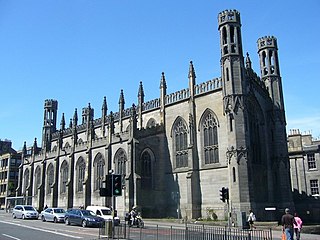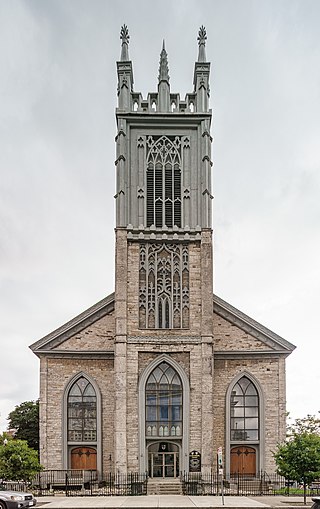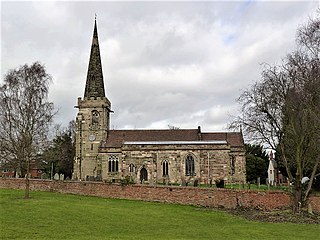
St. John's Episcopal Church, Lafayette Square is a historic Episcopal church located at Sixteenth Street and H Street NW, in Washington, D.C., along Black Lives Matter Plaza. The Greek Revival building, designed by Benjamin Henry Latrobe, is adjacent to Lafayette Square, one block from the White House. It is often called the "Church of the Presidents".

The Church Farm School (CFS) is a private secondary Christian school in Exton, Pennsylvania, United States. In 1985, the campus was listed as a historic district by the National Register of Historic Places.

St. Peter's Church is a historic Episcopal church located on the corner of Third and Pine Streets in Philadelphia, Pennsylvania. It opened for worship on September 4, 1761 and served as a place of worship for many of the United States Founding Fathers during the period of the Continental Congresses. The building was designated a National Historic Landmark in 1996. The church remains an active parish; the current priest-in-charge is the Rev. Dr. Clarke French.

St Paul's and St George's Church is an evangelical church of the Scottish Episcopal Church in central Edinburgh, Scotland. It is located on the corner of Broughton Street and York Place in the east end of Edinburgh's New Town, and is protected as a category A listed building.

St Peter's Church is the parish church of Prestbury, Cheshire, England. It is probably the fourth church on the site. The third, the Norman Chapel, stands in the churchyard. The church is recorded in the National Heritage List for England as a designated Grade I listed building. The Norman Chapel, the lychgate and west wall, the Hearse House, and the sundial in the churchyard are listed at Grade II. It is a Church of England parish church in the diocese of Chester, the archdeaconry of Macclesfield, and the deanery of Macclesfield.

St. Paul's Episcopal Church in Troy, New York, United States, is located at Third and State streets. It is home to one of the oldest congregations in the city. In 1979, the church and two outbuildings were added to the National Register of Historic Places. Seven years later, when the Central Troy Historic District was created and added to the Register, it was listed as a contributing property.

Christ Church — known also as Christ Church, Washington Parish or Christ Church on Capitol Hill — is a historic Episcopal church located at 620 G Street SE in Washington, D.C., USA. The church is also called Christ Church, Navy Yard, because of its proximity to the Washington Navy Yard and the nearby U.S. Marine Barracks.

Christ Church, founded in 1817, is a historic Episcopal church located at 31st and O Streets, Northwest, Washington, D.C., in the Georgetown neighborhood. Its first rector was Reuel Keith (1792–1842), who with William Holland Wilmer rector of St. Paul's Church in 1818 founded an Education Society to train Episcopal priests. Rev. Keith left this parish in 1820 to accept a position at Bruton Parish Church and teach at the College of William and Mary in Williamsburg, Virginia, although he later returned to the new national capital and taught at the Virginia Theological Seminary when it was founded in 1823.

St Leonard's Church is in Sandridge, a village in Hertfordshire, England. It is an active Anglican parish church. The building is Grade II* listed: notable features include its chancel arch made from recycled Roman brick.

Calvary Episcopal Church is a parish of the Episcopal Diocese of Pittsburgh, Pennsylvania. The parish was founded in 1855.

St. Thomas' Episcopal Church is a parish of the Episcopal Church in Owings Mills, Baltimore County, Maryland, part of the Diocese of Maryland. It is noted for its historic parish church, built in 1743.

St. Paul's Church is an historic Episcopal church located near the village of Fairlee, southwest of Chestertown, Kent County, Maryland. St. Paul's Church is one of the original thirty parishes created in 1692 by an Act of the General Assembly declaring the Church of England as the established religion of the Province of Maryland. The Georgian-styled building, completed in 1713, is the second-oldest Episcopal church on the Eastern Shore of Maryland.

St George's Church, Beckenham is the Church of England parish church of Beckenham, Greater London. It is Grade II* listed.

Trinity Episcopal Church is a parish church in the Diocese of Iowa. The church is located in Muscatine, Iowa, United States. It was individually listed on the National Register of Historic Places in 1974. In 2006 it was included as a contributing property in the Downtown Commercial Historic District.

St Saviour's Church is a historic 19th-century Anglican church in the town of Tetbury, Gloucestershire, England under the care of The Churches Conservation Trust. It was designed by the architect Samuel Daukes. Augustus Welby Northmore Pugin and John Hardman undertook the design and execution of the chancel roof. St Saviour's is recorded in the National Heritage List for England as a designated Grade II* listed building.

The Church of Saint Luke and The Epiphany is an Episcopal congregation located at 330 South 13th Street between Spruce and Pine Streets in the Center City neighborhood of Philadelphia, Pennsylvania. It is part of the Diocese of Pennsylvania. The church was formed in 1898 as a result of the merger of St. Luke's Church (1839) and The Church of The Epiphany (1834), which consolidated at St. Luke's location.

All Saints Church is a Grade I listed Anglican church in Barrowby, Lincolnshire, England. The church is 2 miles (3.2 km) west from Grantham on a hillside overlooking the Vale of Belvoir, and to the south of the A52. All Saints is in the ecclesiastical parish of Barrowby and Great Gonerby.

St Mary the Virgin is the Church of England parish church for East Barnet within the Diocese of St Albans. It is located on Church Hill.
![<span class="mw-page-title-main">St Botolph's Church, Quarrington</span> Church in Quarrington, [[Lincolnshire]], England](https://upload.wikimedia.org/wikipedia/commons/thumb/a/a4/Quarrington%2C_St_Botolph%27s_church_-_49697149402.jpg/320px-Quarrington%2C_St_Botolph%27s_church_-_49697149402.jpg)
St Botolph's Church is an Anglican church in Quarrington in Lincolnshire, England. The area has been settled since at least the Anglo-Saxon period, and a church existed at Quarrington by the time the Domesday Book was compiled in 1086, when it formed part of Ramsey Abbey's fee. It was granted to Haverholme Priory in 1165, and the Abbey claimed the right to present the rector in the 13th century.

St Mary's Church is a parish church of the Church of England in Rolleston on Dove, Staffordshire. Parts of the structure date to 1130, though it was extensively renovated in 1892. It is unusual in having the main entrance door on the north side, with the southern entrance reserved for members of the Mosley family, local landowners and key donors to the church. The church features stained glass windows dating to the medieval period and others by Victorian designer Charles Eamer Kempe. The tower houses eight bells, one dating to 1586. The church is grade I listed and there are associated grade II listings for churchyard railings, a memorial, the lychgate and a former church grammar school. The lychgate, by Lincolnshire architect Cecil Greenwood Hare, also functions as a war memorial.




















![<span class="mw-page-title-main">St Botolph's Church, Quarrington</span> Church in Quarrington, [[Lincolnshire]], England](https://upload.wikimedia.org/wikipedia/commons/thumb/a/a4/Quarrington%2C_St_Botolph%27s_church_-_49697149402.jpg/320px-Quarrington%2C_St_Botolph%27s_church_-_49697149402.jpg)


